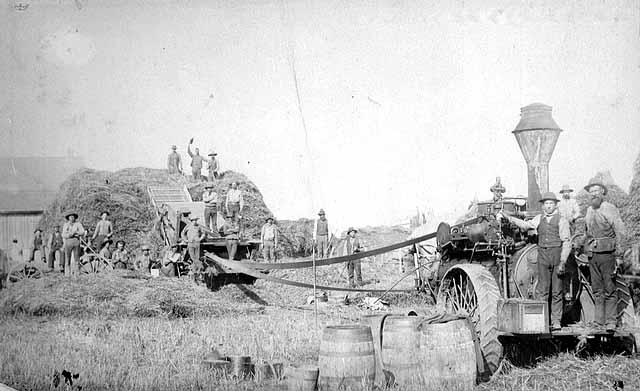
Choose a Menu
What Is That Machine?
.jpeg)
R. Hoffhein's Mower and Reaper! (1864)
Minnesota Historical Society Poster Collection, SA2.5 a7
Introduced in the 1850s, self-raking reapers cut the wheat and gathered it into bunches to be bound and threshed. Fifty years earlier, reaping was done by hand with the centuries-old technology of the sickle. The horse-drawn reaper appeared in the 1830s. It cut the grain faster and better, but still required a worker with a rake to gather the wheat into useful bundles.
Raking was difficult work. In 1861 a farmer near Hastings, Minnesota, described his feelings in his diary:
"Oh, how racked in body I feel. Sore and lame all over my body; fingers cut up etc. It is absolutely hard work to follow a reaper."
Levi N. Countryman papers, 1858-1862.
Minnesota Historical Society Manuscripts Collection
Threshing

Threshing rig of C. R. Chrislock, Goodhue County, 1880-1889.
Minnesota Historical Society Photograph Collection, Location no. SA4.6 r70 Negative no. 45655
"As soon as the grain was hard enough, the [threshing] machine was moved into the centre of the field and 'set.' Six teams with their drivers, three pitchers in the field, and two band-cutters, one on each side of the feeder, were necessary to supply the wants of the wide-throated monster. It was stacking and threshing combined. A wagon at each "table" kept the cylinder busy chewing away, while the other teams were loading. At the tail of the stacker, a boy with a pair of horses hitched to the ends of a long pole hauled away the straw and scattered it in shining yellow billows on the stubble, ready to be burned."
—Hamlin Garland, 1899.
Hamlin Garland. Boy Life on the Prairie (NY: Harper & Brothers, 1899).
Machinery, Productivity, and Debt

Esterly reaper in operation in grain field, St. Paul, 1860.
Minnesota Historical Society Photograph Collection, SA4.52 r59
"In 1800 farmers planted seed by hand and harvested with a scythe and cradle. By 1900 4-horse gang plows turned the soil over four furrows at a pass, grain drills planted the seed, and self-binding reapers brought in the harvest."
—David Stevens "The Mechanization of Farming, 1800-1920"
Continuing advances in technology changed farming from the 1860s to the end of this period. New horse-drawn plows, reapers, threshers, and other machines make it possible to grow more food per acre with less labor. Farmers could then make more money from the same amount of land.
On the other hand, machinery was expensive and farmers didn't normally have much money. They took out loans to buy the latest gadget; or, with new capacity they would take on a mortgage for more land. A bad year could leave them in serious debt. The Carpenter family was always burdened by debt:
"If we had had an ordinarily good crop we could have been entirely out of debt this last fall. We had 150 acres of wheat, but it did not even pay expenses. We have to buy our flour, paying $3.50 a hundred. "
—Mary Carpenter letter, Jan 1, 1882
"The grain is looking very fine, if nothing comes to destroy it. George has 260 acres in, 200 of it rented land. We hope if the prices are good to get out of debt next fall."
—Mary Carpenter letter, July 22, 1883
"It is the same old thing debt & being trammeled on account of it....
"If the children do well, & keep out of debt I shall have good cause for gratitude whether we ever are even with the world or not."
—Mary Carpenter letter, March 31, 1887
